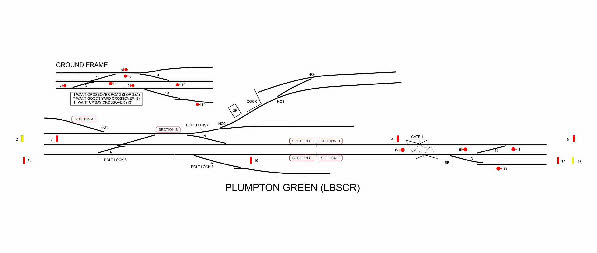
PLUMPTON GREEN - LBSCR c 1910
THE LAYOUT
Our model is very closely based on Plumpton as it was in the period 1900-1914. Inevitably some compromises have been made (hence the name ‘Plumpton Green’). The station limits have been shortened a little, and the layby sidings have been truncated, with most of the length of each siding ‘off-scene’. The only significant changes we have made to the facilities are the provision of the up bay to add some operational interest (principally intended for horse boxes), and the connection from a brickworks at the London end.
The layout is controlled by a fully interlocked mechanical lever frame, with miniature Tyer’s two-position block instruments for communication between the main signal box and the fiddle yards.
The layout requires six operators, and expenses for transport to and from exhibitions are likely to be in the region of £350-400 for a show within the south-east. An estimate can be provided for more distant locations.
More details and photographs are available at http://www.lbscrmodels.co.uk/pg1.html and following pages. Several videos are posted on YouTube - search for ‘This is Plumpton Green’.
Contact: barryluck@home.co.uk
A BRIEF HISTORY
In the early 1900’s, Plumpton was a small settlement between Lewes and Ditchling in East Sussex. In 1847 the railway arrived, passing about 2 miles to the north of the village, when the link between Keymer Junction and Lewes was built by the London Brighton and South Coast Railway.
A station was eventually constructed in 1863 and Plumpton Race-course was opened in 1886, immediately south of the station, which seems to have triggered significant improvements, completed in 1891 – a new signal cabin, with capstan operated crossing gates, and an enlarged goods yard. At either end of the station layby sidings were provided, each about 1000ft long, used primarily on race days to accommodate race specials.
The Keymer Junction-Lewes line remains an important link to London, and much of the 1863 station remains, although the goods yard has long gone. In its heyday it would have seen race specials, pick-up goods and the Newhaven boat service as well as stopping and through passenger trains.
THE TRACK PLAN

THE LAYOUT
Our model is very closely based on Plumpton as it was in the period 1900-
The layout is controlled by a fully interlocked mechanical lever frame, with miniature Tyer’s two-
The layout requires six operators, and expenses for transport to and from exhibitions are likely to be in the region of £350-
More details and photographs are available at http://www.lbscrmodels.co.uk/pg1.html and following pages. Several videos are posted on YouTube -
Contact: barryluck@home.co.uk
A BRIEF HISTORY
In the early 1900’s, Plumpton was a small settlement between Lewes and Ditchling in East Sussex. In 1847 the railway arrived, passing about 2 miles to the north of the village, when the link between Keymer Junction and Lewes was built by the London Brighton and South Coast Railway.
A station was eventually constructed in 1863 and Plumpton Race-
The Keymer Junction-
THE TRACK PLAN
